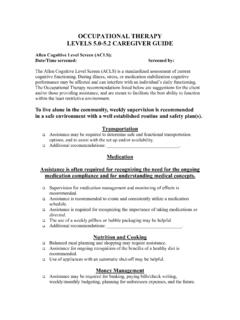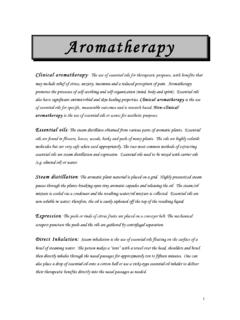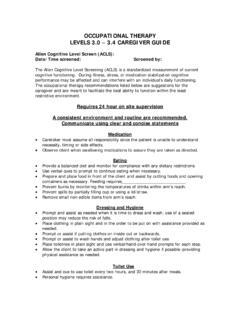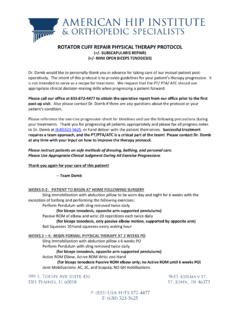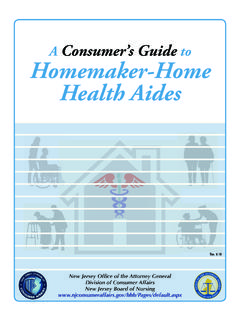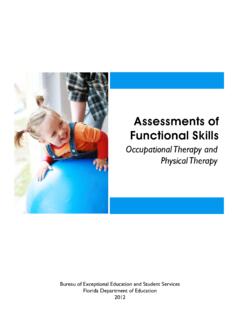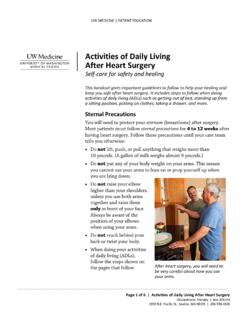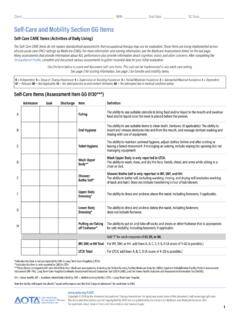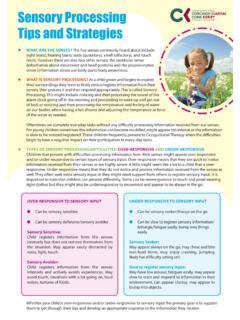Transcription of OCCUPATIONAL THERAPY LEVELS 3.6 – 3.8 CAREGIVER …
1 OCCUPATIONAL THERAPY . LEVELS CAREGIVER GUIDE. Allen Cognitive Level Screen (ACLS): Date/Time screened: Screened by: The Allen Cognitive Level Screening (ACLS) is a standardized measurement of current cognitive functioning. During illness, stress, or medication stabilization cognitive performance may be affected and can interfere with an individual's daily functioning. The OCCUPATIONAL THERAPY recommendations listed below are suggestions for the client and/or CAREGIVER and are meant to facilitate the best ability to function within the least restrictive environment.
2 Requires 24 hour on site supervision Communicate using clear and concise statements Transportation must be provided, as needed Medication CAREGIVER must assume all responsibility since the patient is unable to understand necessity, timing or side effects. Observe when swallowing medications to assure they are taken as directed. Nutrition Provide a balanced diet and monitor that meals are eaten, fluids are taken in regularly and that any dietary restrictions are followed. Prepare and place food in front of the person and assist by cutting foods and opening containers as necessary.
3 Feeding requires_____. Dressing and Hygiene Prompt when it is time to dress and wash. Prompt to wash hands and adjust clothing after toilet use, provide assist if needed. Place toiletries in plain sight; they may not look for objects. Give verbal prompts for each step in sequence. Place clothing in plain sight and in the order to be put on. Allow the client to take an active part in dressing and hygiene and provide assistance as needed. Remember the person may not ask for help or recognize the need for it. Safety recommendations A safe environment and close monitoring is needed.
4 Place name on door of bedroom, particularly when in new environments. Barricade open stairwells and install gates, especially at night. Intercom systems, night-lights, security doors or locks may prevent wandering and/or getting lost. Leave bed side-rails down to prevent climbing over. Assist in and out of shower to prevent falls. A tub bench or seat, grab bars and a hand-held shower are often useful. Bathing and dressing from a seated position may help those at risk for falls. Monitor the temperature of water to avoid scalding. Remove unsteady furniture as the person may grab onto it for support, especially in the bathroom.
5 Small rugs and objects on the floor create increase the probablitiy for falls. Medications and toxic chemicals should be kept locked out of reach. Supervise closely when near the stove (may be impulsive and touch hot burner). Activities Encourage engaging in meaningful activities to prevent sitting for extended periods of time. Provide daily social opportunities and facilitate engagement when needed. Use repetitive tasks (polishing, sanding, folding) or basic crafts/activities. Place objects directly in front of the person. Give limited choices and fully set up the activity.
6 Demonstrate each step and provide cues to keep going . Allow extra time for all activities due to slow pace. Provide a place to sit and watch activities of others. Provide calming environment: consider lighting, sound, and amount of stimulation. Encourage daily activities providing range of motion/movement ( , routine walks or simple seated stretches when appropriate). Provide a calm yet sensory rich environment to prevent both over-stimulation and/or sensory deprivation. Music and singing are often enjoyed, particularly music that is meaningful or from the person's era.
7 O Refer to enclosed sensory diet form for additional recommendations. Reference Allen, , Blue, T., & Earhart, C. (1995). Understanding Cognitive Performance Modes. Ormond, Florida: Allen Conferences. Compiled by: Tina Champagne , OTR/L Allen Authorized Advisor ~ 12/2003 rev
